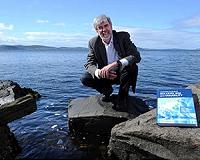| . |  |
. |
Tampere, Finland (SPX) Oct 18, 2010 Atmospheric fine particles affect the Earth's radiation balance by interacting with solar radiation and by participating in cloud formation. Biogenic volatile organic compounds are key players in new particle formation processes. Hence, terrestrial vegetation has an important role as the newly formed particles cool our climate. The chemical composition of such secondary organic aerosol (SOA) particles formed from volatile compounds emitted by vegetation is very complicated and only limited information on the phase state of SOA particles has been available. Thus the scientific community has tried to understand the chemical composition and physical characteristics of SOA particles in order to better understand their climatic implications and also to enable more accurate predictions using global climate models. Until now, biogenic SOA particles have been represented as liquid droplets in global climate models. But according to the new research published in Nature, the physical state of SOA particles formed in coniferous forest is solid, most likely glassy soon after their formation. One can figure these aerosol particles as tiny children's glass marbles, says Professor Thomas Koop from Bielefeld University, Germany. The experimental research has been conducted by the group of scientists from Finnish and German universities and institutes (Tampere University of Technology, University of Eastern Finland, Finnish meteorological institute, University of Helsinki, Bielefeld University, and Max Planck Institute for Chemistry). The discovery was made in University of Eastern Finland's experimental laboratory designed by Dr Jorma Joutsensaari. In the experiments, fine particles formed from volatile compounds emitted by scots pines were studied under controlled conditions, and additional measurements were carried out in a coniferous forest in Hyytiala, Finland. The research results were achieved using a new method developed at Tampere University of Technology by Dr Annele Virtanen. The method is based on collecting particles by impaction on metal substrates. If the particles are solid, they bounce off the surface whereas liquid particles do not bounce but adhere to the substrate, says Virtanen. The results will re-direct the atmospheric fine particle research The new findings will change many features of the understanding of particle behavior in the atmosphere as the physical state of the particles influences their ability to absorb and release water and other gaseous compounds, as well as their ability to act as cloud or ice nuclei. The solid state affects also the aging and lifetime of the chemical components of air particulate matter by reducing the rates of diffusion and reaction in the particles. There have been some discrepancies in previous research results related to SOA particle characteristics, which might be explained by the solid state of the particles. Without doubt our results will re-direct the SOA related research worldwide, comments Professor Ari Laaksonen from Finnish Meteorological Institute. Annele Virtanen, Jorma Joutsensaari, Thomas Koop, Jonna Kannosto, Pasi Yli-Pirila, Jani Leskinen, Jyrki Makela, Jarmo Holopainen, Ulrich Poschl, Markku Kulmala, Douglas Worsnop, Ari Laaksonen: "An amorphous solid state of biogenic secondary organic aerosol particles" Nature (14th October, 2010), DOI:
Share This Article With Planet Earth
Related Links Tampere University of Technology Climate Science News - Modeling, Mitigation Adaptation
 We Will Need To Adapt To Rising Sea Levels
We Will Need To Adapt To Rising Sea LevelsCanberra, Australia (SPX) Oct 18, 2010 The authors of a new book have called for the development of more robust international ocean and ice sheet monitoring and modelling programs designed to help community adaptation planning keep pace with the threat of rising sea levels. "The good news is that a recent concentration of science resources is improving our insight into ocean and ice dynamics, and scientific measurement of the r ... read more |
|
| The content herein, unless otherwise known to be public domain, are Copyright 1995-2010 - SpaceDaily. AFP and UPI Wire Stories are copyright Agence France-Presse and United Press International. ESA Portal Reports are copyright European Space Agency. All NASA sourced material is public domain. Additional copyrights may apply in whole or part to other bona fide parties. Advertising does not imply endorsement,agreement or approval of any opinions, statements or information provided by SpaceDaily on any Web page published or hosted by SpaceDaily. Privacy Statement |